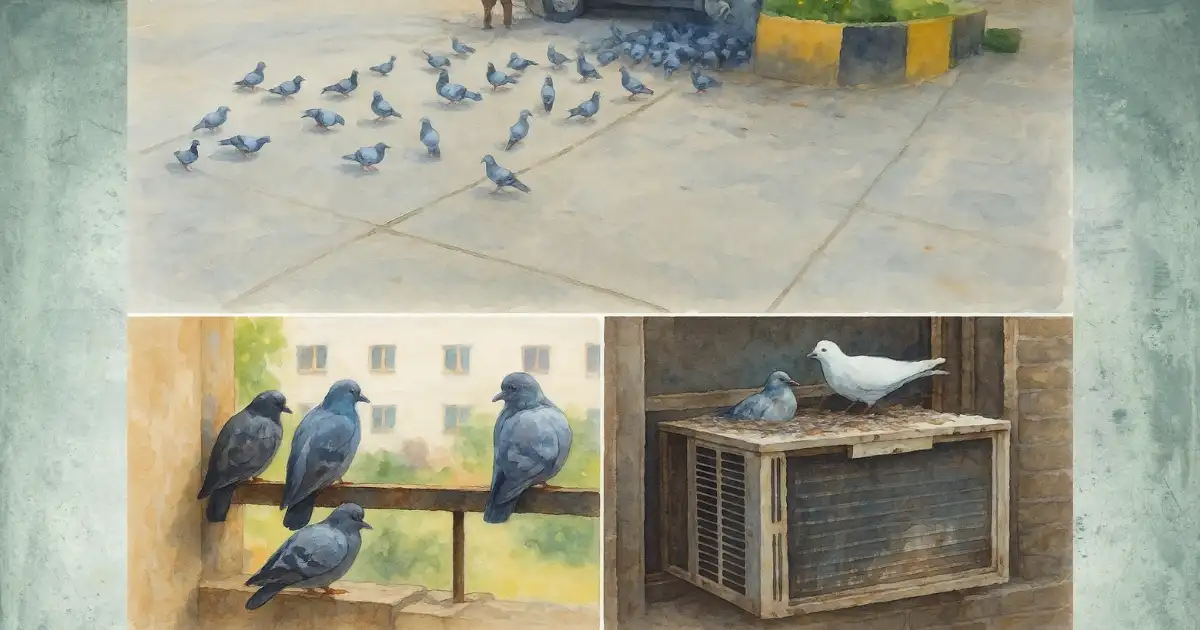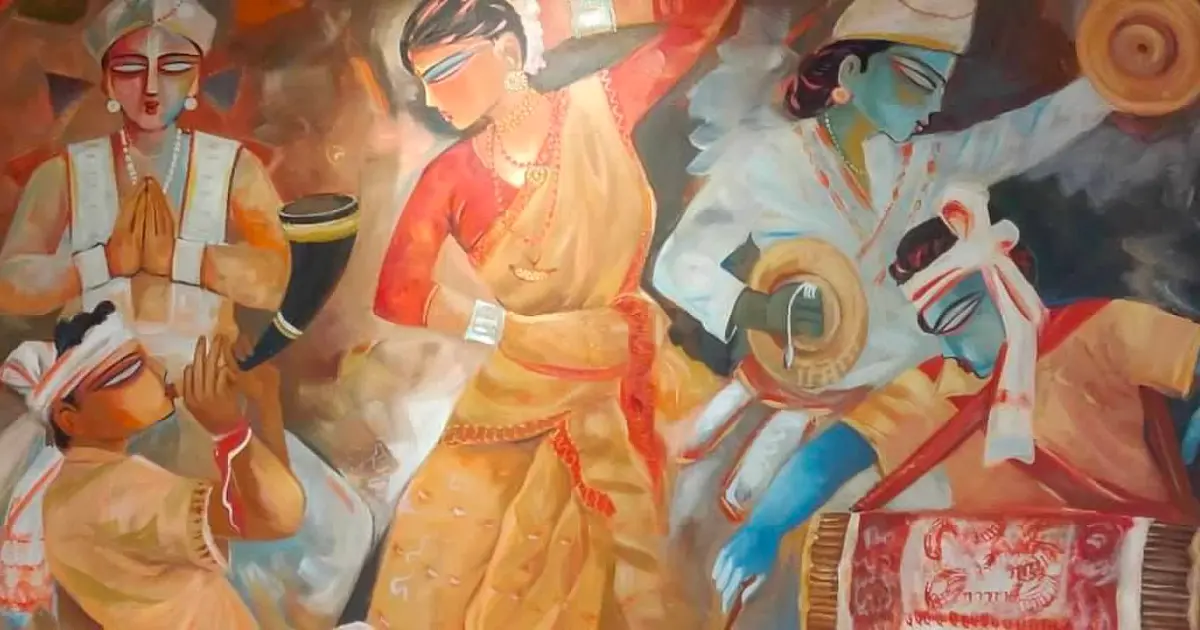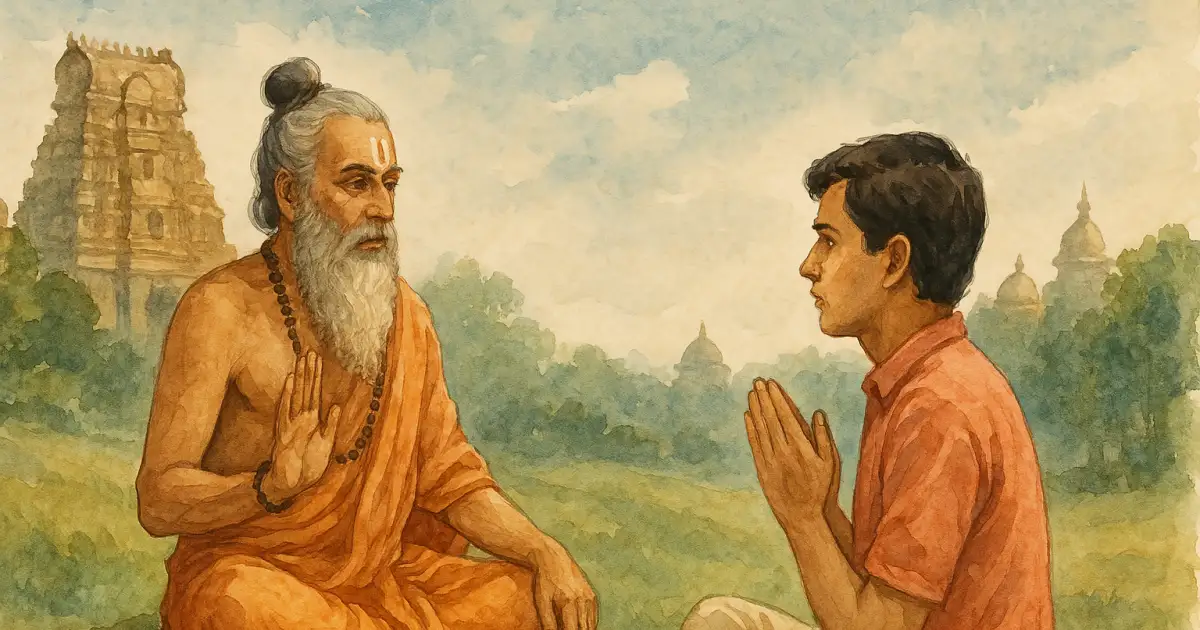Introduction
In the bustling streets of contemporary India, where towering apartments pierce the sky and millions navigate dense urban landscapes, an unexpected challenge has emerged that bridges millennia of human experience: Pigeon populations have increased by over 150% in the past two decades across Indian cities, creating what experts now recognize as a significant public health crisis. Yet, this modern predicament finds a remarkable parallel in one of India's greatest epics, where the Mahābhārata offers detailed guidance on handling the uninvited entry of pigeons into human dwellings.
The ancient Indian tradition of Vāstu Śāstra and ritual practices encompasses detailed guidance for maintaining harmony between humans and their environment. Among the various omens and their remedies discussed in classical texts, the unexpected entry of a pigeon into one's home holds particular significance. The Mahābhārata contains a fascinating dialogue between Yudhiṣṭhira and Bhīṣma on this very subject, offering both recognition of the problem's gravity and practical solutions that remain startlingly relevant today.
The Ancient Inquiry: When Kings Sought Wisdom
The conversation begins with Yudhiṣṭhira, the eldest of the Pāṇḍava brothers, seeking wisdom from the venerable Bhīṣma:
युधिष्ठिर उवाच -
कपोतो यदि गाङ्गेय!
निविशत्यालयं नृणाम् ।
कथं शान्तिर्भवेत् तस्य
क्षिप्रमेतद्वदस्व मे ।kapoto yadi gāṅgeya!
niviśatyālayaṃ nṛṇām ।
kathaṃ śāntirbhavet tasya
kṣiprametadvadasva me।।
Vācaspati, 1968, pp. 1673, 1674Yudhiṣṭhira said: O Bhīṣma (Gāṅgeya), if a pigeon enters and settles in someone's house, what should be done to bring peace? Please tell me quickly.
This question reveals the ancient understanding that certain events in nature, particularly the uninvited entry of specific animals into human dwellings, were considered significant omens requiring immediate attention. The urgency in Yudhiṣṭhira's request - tell me quickly - mirrors the contemporary recognition that pigeon problems require prompt intervention to prevent escalation.
The Ancient Diagnosis: A Warning That Echoes Through Time
Bhīṣma's response is both direct and concerning, establishing the severity of the situation:
भीष्म उवाच -
प्रविष्टे सदनं राजन्!
कपोतेभयकारिणि ।
उत्सन्नं जायते सद्म
नात्र कार्य्या विचारणा ।praviṣṭe sadanaṃ rājan!
kapote bhayakāriṇi |
utsannaṃ jāyate sadma nātra kāryyā vicāraṇā ||
Vācaspati, 1968, pp. 1673, 1674Bhīṣma said: O King! When a pigeon, which is considered inauspicious, enters a house, the house faces ruin. There is no doubt or deliberation needed in this.
The ancient sage continues to elaborate on the specific misfortunes that may befall the household:
अथ वा सद्मनःस्वामी
त्वरितं मृत्युमाप्नुयात् ।
गेहिनी वा सुती वापि
राजा कुप्यति वा भृशम् ।atha vā sadmanaḥ svāmī
tvaritaṃ mṛtyum āpnuyāt |
gehinī vā sutī vāpi
rājā kupyati vā bhṛśam ||
Vācaspati, 1968, pp. 1673, 1674Either the master of the house may quickly meet death, or the wife, or a woman in childbirth may suffer, or the king may become very angry (with the resident).
The text emphasizes the comprehensive nature of the disturbance:
येन केन प्रकारेण
प्रोत्सन्नं जायते गृहम् ।
न च संपद्यते राजन्!
कपोते सदनं गते ।yena kena prakāreṇa
protsannaṃ jāyate gṛham |
na ca saṃpadyate rājan!
kapote sadanaṃ gate ||
Vācaspati, 1968, pp. 1673, 1674In any of these ways, the household becomes disturbed and disrupted. Once the pigeon enters the house, prosperity will not remain.
Modern Validation of Ancient Concerns
The contemporary relevance of this ancient wisdom becomes startling when we examine the current state of urban India's relationship with pigeons. Today's Indian cities face an unprecedented challenge with feral pigeon populations, and the health implications are severe and well-documented by modern medical science.
A single pigeon can generate 12-15 kilograms of droppings annually, and these droppings can remain suspended in air - easily traveling into human lungs, with effects compounded by poor urban air quality. Bird Fancier's Lung (BFL), a type of hypersensitivity pneumonitis, is caused by immune responses to inhaled allergens from bird droppings and feathers. This condition can progress from acute symptoms like fever and breathing difficulties to chronic pulmonary fibrosis, which can ultimately prove fatal.
A 2019 study published in Lung India found that exposure to birds showed the highest odds of developing hypersensitivity pneumonitis compared to other environmental factors. The scope of this health threat extends beyond respiratory issues. Diseases associated with pigeon droppings include Cryptococcosis, Histoplasmosis, and Psittacosis, which can be contracted by breathing in the dust created during cleanup of feathers and droppings. A 2022 study by AIIMS revealed that nearly 15% of respiratory patients in urban hospitals were exposed to allergens linked to pigeons.
The ancient text's recognition of pigeons as bhayakāriṇi (fear-causing) and vighnakārakaḥ (trouble-causing) aligns remarkably with contemporary descriptions of pigeons as urban pests or, in more colorful modern terminology, flying rats.
The First Remedy: The Decisive Approach
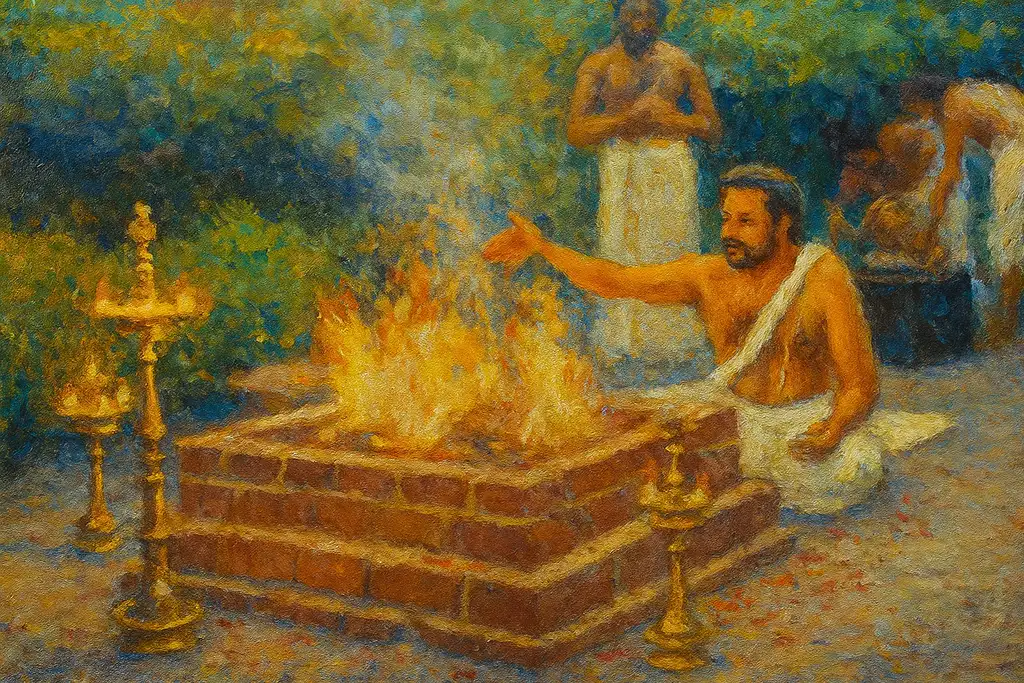
Bhīṣma presents the primary solution with his characteristic directness:
निर्विशेत्सदनं यस्तु
कपोतो विघ्नकारकः ।
स हन्तव्यो मृतस्यास्य
मेदसा जुहुयात् सुधीः ।nirviśet sadanaṃ yastu
kapoto vighnakārakaḥ |
sa hantavyo mṛtasyāsya
medasā juhuyāt sudhīḥ ||
Vācaspati, 1968, pp. 1673, 1674That trouble-causing pigeon must be removed. A wise person should destroy it, and its fat (after death) should be offered in the sacred fire (homa) for peace.
This remedy reflects the ancient understanding that sometimes, decisive action is necessary to restore harmony, followed by a ritual offering to neutralize any negative consequences. In modern context, this aligns with contemporary pest-control methods that prioritize human health over individual animal welfare. Current professional approaches include lethal control methods, though experts note these often provide only short-term relief as populations rapidly breed back. The ancient emphasis on ritual purification after taking life also demonstrates an ethical awareness of the gravity of such action.
The Compassionate Alternative: A Sophisticated Symbolic Solution
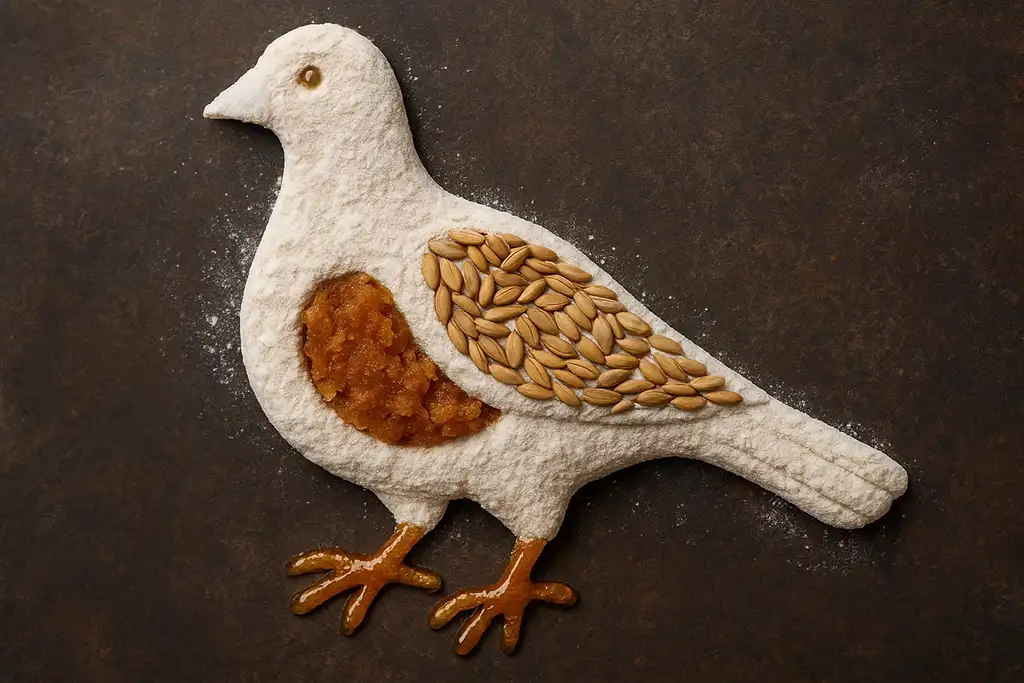 Representative image generated by Sora AI
Representative image generated by Sora AI
Recognizing that not everyone would be comfortable with the first approach, Bhīṣma provides an elaborate alternative for those who prefer non-violence:
जीवनेच्छा कपोते चेद्
विधानान्तरमस्ति तत् ।
शालीनां पिष्टमादाय
पयसालोड्य तत् पुनः ।jīvanecchā kapote ced
vidhānāntaraṁ asti tat |
śālīnāṃ piṣṭam ādāya
payasā loḍya tat punaḥ ||
Vācaspati, 1968, pp. 1673, 1674But if one desires to keep the pigeon alive, there is another method. One must make a paste of rice flour and knead it with milk.
This alternative demonstrates the sophisticated understanding of symbolic representation in ancient Indian practices. The detailed instructions continue thus:
विदधीत कपोतस्य
रूपं शास्त्रविचक्षणः ।
गुडेनोदरमापूर्य्य मुखं शर्करया पुनः ।vidadhīta kapotasya
rūpaṃ śāstra-vicakṣaṇaḥ |
guḍenodaram āpūryya
mukhaṃ śarkarayā punaḥ ||
Vācaspati, 1968, pp. 1673, 1674An expert in rituals should make an image of the pigeon using this paste. The belly should be filled with jaggery, and the mouth with sugar.
मधुना चरणौ तस्य
पक्षौ धान्येन पक्षिणः ।
ततो वह्निमुखं कृत्वा
हावयेत् प्रयतः सुधीः ।madhunā caraṇau tasya
pakṣau dhānyena pakṣiṇaḥ |
tato vahnimukhaṃ kṛtvā
hāvayet prayataḥ sudhīḥ ||
Vācaspati, 1968, pp. 1673, 1674The feet should be smeared with honey and the wings with grains. Then, turning this pigeon image towards the fire, one should offer it in the sacred fire with devotion.
Here, each component in the set of instructions signifies benefits and prosperity - for both the human resident and the pigeon:
- Rice flour and milk: Basic sustenance representing purity and nourishment.
- Jaggery in the belly: Sweetness to appease and satisfy.
- Sugar in the mouth: Sweet words and peaceful communication.
- Honey on feet: Ensuring the pigeon’s journey away is pleasant.
- Grains on wings: Providing sustenance for flight.
- Fire offering: Transformation and purification through sacred flame.
This compassionate approach parallels a few modern, more humane pest-control methods that seek to deter the pest rather than destroy it, including birth control tactics, physical deterrents like spikes and netting, and habitat modification. Moreover, the symbolic offering, rather than killing the pigeon and offering it physically, serves the same psychological function as the modern humane solutions: these allow people to address the problem, while maintaining their ethical integrity.
The Root of the Modern Crisis
What makes this crisis particularly troubling is its human-driven nature. The rapid increase in pigeon numbers stems from the ready food supply; easy nesting areas in high-rise buildings to which pigeons easily adapt; and prolific pigeon breeding, with most of their nutrition again coming from food voluntarily provided by humans. This well-intentioned feeding of pigeons by humans has created an ecological imbalance: the 2023 State of India's Birds report noted that increased food availability results in behaviorally dominant species, like pigeons, crowding out other bird species.
The Mahābhārata's dual approach reveals deep insight into human psychology and social dynamics. The text recognizes that effective solutions must accommodate different temperaments and moral frameworks. This psychological sophistication mirrors modern public health challenges around pigeon management. While experts universally recommend stopping the public feeding of pigeons to reduce populations naturally, implementation remains difficult because feeding birds provides emotional satisfaction and perceived spiritual merit for people everywhere.
Lessons for Contemporary Urban Management
The Mahābhārata's approach to pigeon problems also offers several insights relevant to modern urban management:
- Recognition of Severity: Both ancient and modern perspectives acknowledge that pigeon intrusion represents a genuine threat to human well-being, not merely an aesthetic annoyance. This recognition justifies serious intervention.
- Multiple Solution Pathways: Effective policy must accommodate different approaches and temperaments. Just as the ancient text provides both decisive and compassionate methods, modern urban management should offer multiple tools - from deterrents and habitat modification, to pigeon population control and public education for people everywhere.
- Ritual and Symbolic Elements: The elaborate symbolic ritual described in the Mahābhārata suggests that purely practical solutions may be insufficient. Modern campaigns might benefit from incorporating culturally resonant elements that satisfy emotional and spiritual needs, while promoting desired behaviors.
- Immediate Action: Both ancient and modern perspectives emphasize the importance of a prompt response. The Mahābhārata's instruction to act quickly aligns with contemporary advice that early intervention prevents larger infestations.
- Community Approach: The text's discussion between a king (representing governance) and a sage (representing wisdom) suggests that effective solutions require coordination between authority and knowledge, comparable to modern needs for collaboration between municipal authorities, health experts, and communities.
Bridging Ancient Wisdom and Modern Solutions
Perhaps the most profound lesson from the Mahābhārata's treatment of pigeon problems lies in its balanced approach that neither dismisses the threat, nor recommends excessive response. The text takes the problem seriously, while providing proportionate solutions that respect both human needs and ethical considerations.
This balance proves particularly relevant as modern Indian cities grapple with pigeon overpopulation. While high numbers don't automatically make pigeons a menace, and these birds do have a place in urban food chains, the health risks are real and documented. The ancient text's dual approach suggests that effective modern solutions should similarly balance health protection with ethical pest management.
The Mahābhārata's guidance also entails that finding a solution to the problem often requires addressing root causes, rather than only wiping away the symptoms. Just as the ritual alternative redirects human impulses toward constructive outcomes, modern solutions must address the human behaviors - particularly feeding - that create and sustain pigeon overpopulation.
Conclusion: Timeless Wisdom for Timeless Challenges
The dialogue between Yudhiṣṭhira and Bhīṣma reveals that human-pigeon conflicts have deep historical roots, and that our ancestors developed sophisticated frameworks for addressing these. The ancient text's recognition of pigeons as potential threats to human welfare, combined with its provision of both practical and symbolic solutions, demonstrates a nuanced understanding that remains relevant today.
This dialogue exemplifies the comprehensive nature of ancient Indian traditions and wisdom. Whether one approaches these teachings from a spiritual, psychological, or cultural perspective, they demonstrate sophisticated understanding of human-animal relationships, along with the power of ritual in maintaining psychological equilibrium.
Today, as Indian cities continue to struggle with pigeon overpopulation and associated health risks, the Mahābhārata's approach offers valuable guidance:
- Take the problem seriously.
- Act promptly.
- Provide multiple solutions that accommodate different mindsets in the population.
- Finally, address the underlying human behaviors that perpetuate the issue.
The text's provision of both decisive and compassionate remedies reflects our tradition's recognition that different temperaments require different approaches to achieve the same goal: the restoration of peace and harmony in the home. In recognizing that even the simple matter of an uninvited pigeon requires thoughtful, multi-faceted response, the Mahābhārata demonstrates anof human-animal relationships that modern urban planners and public health officials would do well to study.
The lesson is clear: whether dealing with ancient household intrusions or modern urban infestations, effective solutions must balance practical necessity with ethical sensitivity, providing pathways that protect human welfare while respecting the complexity of our relationship with the natural world. In this balance, perhaps, lies the true wisdom that bridges the millennia between ancient Saṃskṛta dialogues and contemporary urban challenges.
References
- Vācaspati, T. (Ed.). (1968). Vācaspatyaṃ (Vol. 3, Sanskrit).
